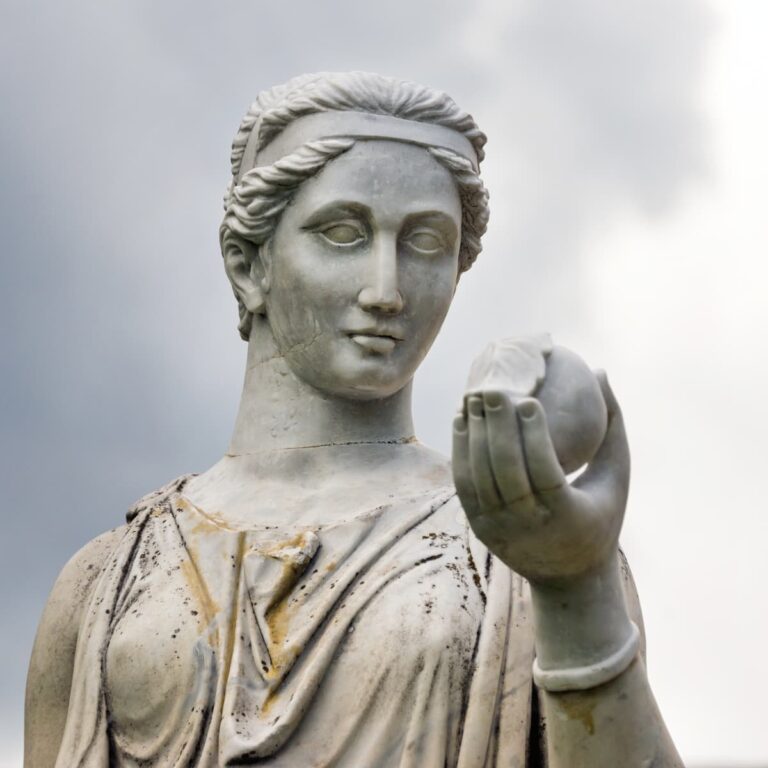The ancient Greek mathematician and philosopher Pythagoras, who lived 2,500 years ago, applied his genius to music as well throughout his brilliant career, creating the Pythagorean comma as part of music theory, and his brilliance is still recognized to this day.
The Pythagorean Theorem remains one of the fundamental concepts in the realm of mathematics and is still taught in schools across the world.
The influence of the Ancient Greek philosopher, who was born on the island of Samos in the year 570 BC, remains strong today in many realms—but, unfortunately, so do the mysteries surrounding him.
Pythagoras’ philosophy influenced both Plato and Aristotle, and through them, his ideas were fundamental in Western philosophy. However, a lesser-known contribution the brilliant theoretician gave to the world is the “Pythagorean comma,” the small interval (or comma) existing in Pythagorean tuning between two enharmonically equivalent notes such as C and B♯, or D♭ and C♯.
Pythagorean Comma part of essential musical theory
His “comma,” which is known to music theoreticians the world over, is used to express the measurements between musical notes on a scale.
In music theory, a comma is a very small interval which is really just the difference resulting from tuning one note two different ways. The word comma used without qualification refers to the syntonic comma, which can be defined, for instance, as the difference between an F♯ tuned using the D-based Pythagorean tuning system and another F♯ tuned using the D-based quarter-comma meantone tuning system.
Intervals separated by the ratio 81:80 are considered the same note because the 12-note Western chromatic scale does not distinguish Pythagorean intervals from 5-limit intervals in its notation. Other intervals are considered commas because of the enharmonic equivalences of a tuning system. For example, in 53TET, B7♭ and A♯ are both approximated by the same interval although they are a septimal kleisma apart.
The word “comma” came via Latin from the Greek κόμμα, from the earlier *κοπ-μα, which means “an act of cutting.”
Within the same tuning system, two enharmonically equivalent notes (such as G♯ and A♭) may have a slightly different frequency, and the interval between them is a comma. For example, in extended scales produced with five-limit tuning, an A♭ tuned as a major third below C5 and a G♯ tuned as two major thirds above C4 are not exactly the same note, as they would be in equal temperament. The interval between those notes, the diesis, is an easily audible comma (its size is more than 40 percent of a semitone).
Commas—the difference in size between two semitones
Commas are often defined as the difference in size between two semitones. Each meantone temperament tuning system produces a 12-tone scale characterized by two different kinds of semitones (diatonic and chromatic) and, hence, by a comma of unique size. The same is true for Pythagorean tuning.
A Pythagorean comma is equal to the frequency ratio (1.5)12⁄27 = 531441⁄524288 ≈ 1.01364, or about 23.46 cents, which is roughly a quarter of a semitone (in between 75:74 and 74:73). The comma that musical temperaments often refer to tempering is the Pythagorean comma.
There is also the Pythagorean comma on C using Ben Johnston’s notation. The note depicted as lower on the staff (B♯+++) is slightly higher in pitch (than C♮).
Pythagorean comma (PC) is defined in Pythagorean tuning as the difference between semitones (A1 – m2), or the interval between enharmonically equivalent notes (from D♭ to C♯). The diminished second has the same width but an opposite direction (from C♯ to D♭).
The Pythagorean comma can be also defined as the difference between a Pythagorean apotome and a Pythagorean limma (i.e., between a chromatic and a diatonic semitone, as determined in Pythagorean tuning), as the difference between twelve just perfect fifths and seven octaves, or as the difference between three Pythagorean ditones and one octave (which is the reason why the Pythagorean comma is also called a ditonic comma).
The diminished second, in Pythagorean tuning, is defined as the difference between limma and apotome. It coincides, therefore, with the opposite of a Pythagorean comma, and can be viewed as a descending Pythagorean comma (e.g. from C♯ to D♭), equal to about −23.46 cents.
As described in the introduction, the Pythagorean comma may be derived in multiple ways.
The difference between two enharmonically equivalent notes in a Pythagorean scale, such as C and B♯ (about this soundPlay (help·info)), or D♭ and C♯ (see below) is one way to derive the Pythagorean comma. Alternatively, it could be the difference between Pythagorean apotome and Pythagorean limma.
It can also be arrived at by the difference between twelve just perfect fifths and seven octaves, or the difference between three Pythagorean ditones (major thirds) and one octave.
A just perfect fifth has a frequency ratio of 3:2. It is used in Pythagorean tuning, together with the octave, as a yardstick to define, with respect to a given initial note, the frequency ratio of any other note.
“Apotome” and “limma” are the two kinds of semitones defined in Pythagorean tuning. The apotome (about 113.69 cents, e.g. from C to C♯) is the chromatic semitone, or augmented unison (A1), while the limma (about 90.23 cents, e.g. from C to D♭) is the diatonic semitone, or minor second (m2).
A ditone (or major third) is an interval formed by two major tones. In Pythagorean tuning, a major tone has a size of about 203.9 cents (frequency ratio 9:8); thus, a Pythagorean ditone is about 407.8 cents.
Greek mathematician and philosopher Pythagoras’ life dogged by hardships and struggle despite brilliance
Around 530 BC, the Greek philosopher traveled to Croton (today’s Crotone) in southern Italy and founded a school. Pythagoras’ schools initiates were sworn to secrecy and lived a communal, ascetic life.
This lifestyle entailed a number of dietary prohibitions, said to include vegetarianism, although some modern scholars doubt that he advocated for the diet.
Pythagoras’ mysterious personality was noticeable during his teaching. Strangely, no notes and questions were allowed in his lessons, which is why a great part of his work was lost. There is no additional information even on the renowned Pythagorean theorem.
It is also not known if Pythagoras invented this theorem on his own or with the help of his students.
He died around 495 BC in Metapontum, Lower Italy, starving himself for forty days because of his grief over the persecution of the Pythagoreans and the killing of the majority of them.
Another ancient account states that Pythagoras was killed for political reasons, as followers of his opponents Cylon and Ninon had attacked the Pythagoreans during a meeting.
Following his death, the Greek philosopher’s house was made into a sanctuary of Demeter, and the road that led to it became a sanctuary of the Muses—an apt transformation, as the great man was responsible for explaining the workings behind the most ephemeral of all the arts, namely that of music.
Source: Greek Reporter







